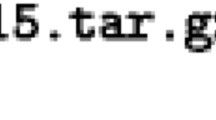Abstract
There has been renewed interest in Barton and Lord’s (An upper asymptote for the three-parameter logistic item response model (Tech. Rep. No. 80-20). Educational Testing Service, 1981) four-parameter item response model. This paper presents a Bayesian formulation that extends Béguin and Glas (MCMC estimation and some model fit analysis of multidimensional IRT models. Psychometrika, 66 (4):541–561, 2001) and proposes a model for the four-parameter normal ogive (4PNO) model. Monte Carlo evidence is presented concerning the accuracy of parameter recovery. The simulation results support the use of less informative uniform priors for the lower and upper asymptotes, which is an advantage to prior research. Monte Carlo results provide some support for using the deviance information criterion and \(\chi ^{2}\) index to choose among models with two, three, and four parameters. The 4PNO is applied to 7491 adolescents’ responses to a bullying scale collected under the 2005–2006 Health Behavior in School-Aged Children study. The results support the value of the 4PNO to estimate lower and upper asymptotes in large-scale surveys.


Similar content being viewed by others
References
Albert, J. (1992). Bayesian estimation of normal ogive item response curves using Gibbs sampling. Journal of Educational and Behavioral Statistics, 17(3), 251–269.
Barton, M A., & Lord, F.M. (1981). An upper asymptote for the three-parameter logistic item-response model (Tech. Rep. No. No. 80-20). Educational Testing Service.
Béguin, A. A., & Glas, C. A. (2001). MCMC estimation and some model-fit analysis of multidimensional IRT models. Psychometrika, 66(4), 541–561.
Brooks, S. P., & Gelman, A. (1998). General methods for monitoring convergence of iterative simulations. Journal of Computational and Graphical Statistics, 7(4), 434–455.
Chang, H.-H., & Ying, Z. (2008). To weight or not to weight? Balancing influence of initial items in adaptive testing. Psychometrika, 73(3), 441–450.
Culpepper, S. A. (2015). An improved correction for range restricted correlations under extreme, monotonic quadratic nonlinearity and heteroscedasticity. Psychometrika,. doi:10.1007/s11336-015-9466-9.
Feuerstahler, L. M., & Waller, N. G. (2014). Estimation of the 4-parameter model with marginal maximum likelihood. Multivariate Behavioral Research, 49(3), 285–285.
Fox, J.-P. (2010). Bayesian item response modeling. New York: Springer.
Gelman, A., & Rubin, D. B. (1992). Inference from iterative simulation using multiple sequences. Statistical Science, 7, 457–472.
Green, B. F. (2011). A comment on early student blunders on computer-based adaptive tests. Applied Psychological Measurement, 35(2), 165–174.
Holmes, D. (1990). The robustness of the usual correction for restriction in range due to explicit selection. Psychometrika, 55, 19–32.
Iannotti, R. (2005). Health behavior in school-aged children HBSC, 2005–2006. Ann Arbor, MI: Inter-university Consortium for Political and Social Research. doi:10.3886/ICPSR28241.v1.
Liao, W., Ho, R., Yen, Y., & Cheng, H. (2012). The four-parameter logistic item response theory model as a robust method of estimating ability despite aberrant responses. Social Behavior and Personality: An International Journal, 40, 1679–1694.
Loken, E., & Rulison, K. L. (2010). Estimation of a four-parameter item response theory model. British Journal of Mathematical and Statistical Psychology, 63(3), 509–525.
Magis, D. (2013). A note on the item information function of the four-parameter logistic model. Applied Psychological Measurement, 37(4), 304–315.
Mendoza, J. (1993). Fisher transformations for correlations corrected for selection and missing data. Psychometrika, 58(4), 601–615.
Ogasawara, H. (2012). Asymptotic expansions for the ability estimator in item response theory. Computational Statistics, 27(4), 661–683.
Patz, R. J., & Junker, B. W. (1999a). Applications and extensions of MCMC in IRT: Multiple item types, missing data, and rated responses. Journal of Educational and Behavioral Statistics, 24(4), 342–366.
Patz, R. J., & Junker, B. W. (1999b). A straightforward approach to Markov Chain Monte Carlo methods for item response models. Journal of Educational and Behavioral Statistics, 24(2), 146–178.
Pham-Gia, T., & Turkkan, N. (1998). Distribution of the linear combination of two general Beta variables and applications. Communications in Statistics Theory and Methods, 27(7), 1851–1869.
Reise, S. P., & Waller, N. G. (2003). How many IRT parameters does it take to model psychopathology items? Psychological Methods, 8(2), 164–184.
Rulison, K. L., & Loken, E. (2009). I’ve fallen and I can’t get up: Can high-ability students recover from early mistakes in CAT? Applied Psychological Measurement, 33(2), 83–101.
Sahu, S. K. (2002). Bayesian estimation and model choice in item response models. Journal of Statistical Computation and Simulation, 72(3), 217–232.
San Martín, E., González, J., & Tuerlinckx, F. (2014). On the unidentifiability of the fixed-effects 3PL model. Psychometrika, 80, 1–18.
Sinharay, S., Johnson, M. S., & Stern, H. S. (2006). Posterior predictive assessment of item response theory models. Applied Psychological Measurement, 30(4), 298–321.
Spiegelhalter, D. J., Best, N. G., Carlin, B. P., & Van Der Linde, A. (2002). Bayesian measures of model complexity and fit. Journal of the Royal Statistical Society: Series B (Statistical Methodology), 64(4), 583–639.
Waller, N. G., & Reise, S. P. (2010). Measuring psychopathology with nonstandard item response theory models: Fitting the four-parameter model to the Minnesota Multiphasic Personality Inventory. In S. Embretson (Ed.), Measuring psychological constructs: Advances in model based approaches. Washington, DC: American Psychological Association.
Zheng, Y., & Chang, H.-H. (2014). On-the-fly assembled multistage adaptive testing. Applied Psychological Measurement, 39, 104–118.
Acknowledgments
The manuscript benefited from the comments of Alberto Maydeu-Olivares, Niels Waller, and three anonymous reviewers. Any remaining errors belong to the author.
Author information
Authors and Affiliations
Corresponding author
Rights and permissions
About this article
Cite this article
Culpepper, S.A. Revisiting the 4-Parameter Item Response Model: Bayesian Estimation and Application. Psychometrika 81, 1142–1163 (2016). https://doi.org/10.1007/s11336-015-9477-6
Received:
Published:
Issue Date:
DOI: https://doi.org/10.1007/s11336-015-9477-6




